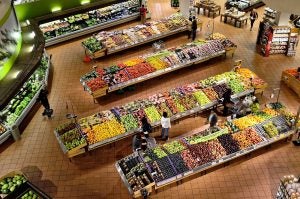Imagine a world where you can cook up a wholesome meal for your family every night without even owning a casserole pan. A world where meal prep does not mean you spend your whole day off shopping, dicing, and slicing and filling the fridge with cute little portion-sized Pyrex dishes you spent too much money on.
That world is here. With companies such as Hello Fresh, Daily Harvest, and Tovala, you can order a week’s worth of meals and snacks to keep you moving without doing any work other than heating the oven.
While frozen meals (long known as “TV dinners”) may have been first introduced on the Swanson truck in 1953 after an abundance of leftover thanksgiving turkey, today’s ready-made meal delivery companies are a little bit different.
Hello Fresh claims to be the first global carbon-neutral meal kit company, but do you believe that? It seems like ordering ingredients, making and packaging hundreds of meals, and delivering them in plastic containers, stuffed in a cooler bag with lots of ice packs, and then all stuffed in a cardboard box to then be driven to lots of houses is a recipe for greenhouse gasses and waste.
So how can such meal-delivery companies tout claims like “sustainable” and “carbon neutral?”
When comparing the waste from homemade meals to ready-made-meal services, we have two kinds of waste we are talking about: food waste vs. plastic waste.

Food waste happens at the farm and processor level, the retail level, and the consumer level. Farmers and processors have to leave behind the bumped and bruised and unripe crops. Retail always has to stock more than they need, which leads to grocery stores throwing out tons of produce, and leads to consumers buying more than they need. According to a 2021 U.S. Department of Agriculture report, about 30 percent of food produced on the farm is later thrown out at the retail and consumer level.
Of the 30 percent of food that gets tossed, Berkeley Economic Review estimates that 10 million pounds of that is thrown out just because it’s ugly! And unfortunately we need to remember that we buy apples and grapes in plastic bags, raspberries and blueberries in plastic shells, shrink-wrapped meat, and plastic jugs of drinks. We consume a lot of packaging in the grocery store.
So we know that being a home chef isn’t perfect, we make a lot of waste whether we realize it or not. But how do our meal prep services compare?
For starters, you don’t discriminate against ugly produce when you only see it in its cooked form. Do you know what those potatoes looked like before being mashed? Meal prep services are able to utilize ugly produce, and even bumped and bruised produce since it is going out for immediate preparation and use.
The biggest factor that makes meal service companies more sustainable than a restaurant or a home chef is the fact that meals are delivered in perfect portions. While at most restaurants you can bank on asking for a box to go, meal prep services bring you just enough for a meal, and no leftovers. This greatly reduces food waste — a study conducted by Hello Fresh even claims that it is as much as a 25 percent reduction.
But does the reduction in food waste make up for the use of lots of packaging?
Actually, it does. The U.S. Environmental Protection Agency estimates that between growing, harvesting, processing, and wasting all the food that never gets consumed, the greenhouse gas emissions impact is equal to 170 million metric tons before the food even composts in the landfill.
Hello Fresh, Daily Harvest, and Tovala generally use recycled and highly recyclable or biodegradable food packaging. You’ll notice that their plastics are mainly recycled plastics, and they are able to utilize paper, aluminum and cardboard, which are some of the most commonly recycled products in the U.S. as opposed to plastic bags or Styrofoam. Tovala meals, for example, come in lots of cardboard packaging, aluminum trays, and a “foam-like” insulating cooler, which is made from No. 1 plastic and can be recycled.
While it’s tough to put a climate price tag on using recycled and recyclable containers, it is safe to say that these containers take up less energy to make than virgin materials. Check out Stanford University’s article on recycling to see some of the ways that recycling reduces energy usage.
This is especially poignant when these companies talk extensively (or even exclusively) about “curbside recycling,” which doesn’t exist across much of the country. Many small towns and rural communities don’t have readily available recycling resources, let alone “curbside,” and even if they do offer recycling at a waste convenience center, it’s often not a full suite of services. Perhaps these delivery services cater to affluent areas or those with urbanized recycling programs, which likely undercuts some of the environmental and sustainability claims made by the delivery services on the packaging side of the business.
All in all, when we look at food waste, meal prep companies win all day. They utilize produce that wouldn’t normally be bought in stores, and they only give out perfect portions, greatly reducing food in landfills. Meal prep companies do use a lot of packaging, but so does buying convenient items in the store, and meal prep services utilize many more recycled containers than seen in the average home chef’s fridge.
If you have been turned off by ready-made-meals at your door, it might be time to take another look. There are many companies out there, and choose your company wisely. Each one stands for their own mission and values, so make sure to pick one that aligns with what you stand up for. One thing they are all good for though is supporting farmers by helping people get back to eating wholesome foods. Plus, what farmer wouldn’t mind a little meal peace of mind during the busy seasons of planting and harvest?
Get ready to toss out those casserole dishes and have meals delivered, because they aren’t as bad as you think!
Elizabeth Maslyn is a born-and-raised dairy farmer from Upstate New York. Her passion for agriculture has driven her to share the stories of farmers with all consumers, and promote agriculture in everything she does. She works hard to increase food literacy in her community, and wants to share the stories of her local farmers.



